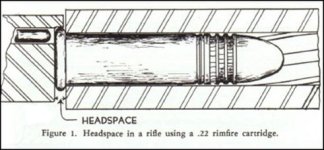chuck s
Member
Right, Brett 
Unless there's been a design change the 15-22 firing pin is physically limited in forward travel. Remove your bolt and press on the firing pin. Press hard. It only goes in so far before it meets a solid stop. Keep pressing forward and look at the face of the bolt. Note that in this pushed forward position the firing pin sticks out the face of the bolt. If it didn't it couldn't fire the cartridge. See Brett's photos.
Good so far? Push it all the way forward again and note that the rear of the firing pin is now flush with the rear of the bolt.
If your firing pin does differently -- and you understand the face of the bolt is the area within the recess -- let us know.
-- let us know.
Unless the firing pin protrudes thru the face of the bolt it can't reach the primer and the rifle will not fire. Or did I say that already.
-- Chuck
Unless there's been a design change the 15-22 firing pin is physically limited in forward travel. Remove your bolt and press on the firing pin. Press hard. It only goes in so far before it meets a solid stop. Keep pressing forward and look at the face of the bolt. Note that in this pushed forward position the firing pin sticks out the face of the bolt. If it didn't it couldn't fire the cartridge. See Brett's photos.
Good so far? Push it all the way forward again and note that the rear of the firing pin is now flush with the rear of the bolt.
If your firing pin does differently -- and you understand the face of the bolt is the area within the recess
Unless the firing pin protrudes thru the face of the bolt it can't reach the primer and the rifle will not fire. Or did I say that already.
-- Chuck


